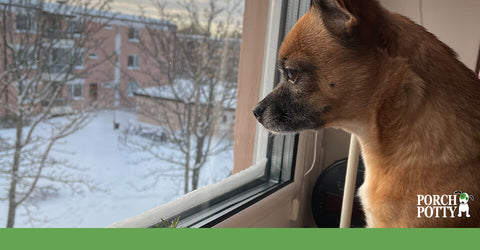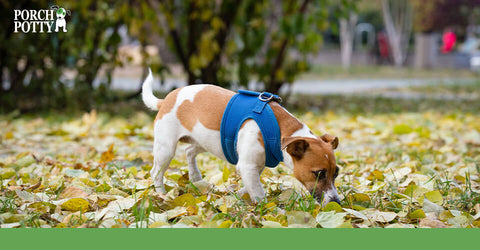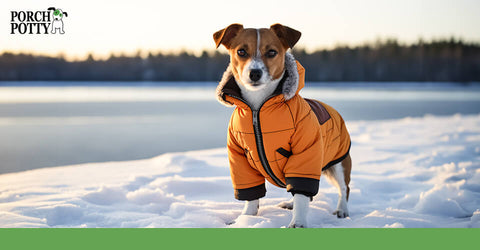
Transitioning from indoor potty training during the winter to outdoor potty training doesn't have to be as difficult as it seems.
An anonymous quote about Canadian winters that really stuck with me is, “If you choose not to find joy in the snow, you will have less joy in your life but still the same amount of snow.” I can’t help but wonder how well this fits in with today’s topic of discussion. A dog to be raised in Canada has to learn to not only step out comfortably in the snow but also love playing in it because of the sheer number of months his backyard is going to be snow-clad.
While breeds like Huskies, Golden Retrievers and German Shepherds take to the snow effortlessly, some other breeds like Yorkies, Chihuahuas and Pugs may need some time and external help getting accustomed to the cold. If your lifestyle involves going outdoors regularly for walks and excursions, it is highly recommended to steer your dog’s training in that direction from day 1.
Transitioning your dog from indoor to outdoor potty training in the harsh Canadian weather may come with a few challenges, but it is in your dog’s best interest to embrace the Canadian winters as early on as possible. Let’s understand ways to make it easier for them.
Winter and Its Effects on Your Dog’s Potty Habits
Winter has different effects on different dogs. If you’re a Husky owner in Canada, you may find yourself out and about in the snow every other hour and chances are your body is as accustomed to the cold as theirs. However, short coated breeds and smaller dogs with hair instead of fur may be a little more sensitive towards the cold. Some ways that their routine habits could get affected are:
- Reduced inclination to step outside, even for potty breaks
- Difficulty in finding the perfect spot to relieve themselves because of all the snow around them
- Preference to pee/poop indoors
- The need to take shorter pee/potty breaks because of the cold
- Several layers of clothing may add some adjustment time and discomfort
All these pointers may act as hindrance in a dog’s natural day to day routine and may trickle down to affect their potty habits.
3 Tips to Keep Your Dog Comfortable and Motivated in Winter
1. Invest in the appropriate gear
Don’t underestimate the power of a good winter gear for your dog. It plays a huge role in keeping your dog safe in the snow. Some dogs may need a nice insulated jacket to keep themselves warm in -10°C whereas some of them may need a little TLC for their paws, in which case, a great pair of fleece-lined boots should do the trick.
Paw pads and noses are the first ones to chap in winters. A coconut oil based balm would help provide extra hydration on those extra cold days.
2. Understand and respond to your dog’s body language
Our dogs are constantly communicating with us, whether we notice it or not. If your dog loves the snow, it is highly likely that they’d forget your existence as soon as you step outside. But, if your dog is unsure about the cold, look out for signs such as shivering, stopping frequently on walks, licking paw pads repeatedly, limping, cramps etc. on your walks and be quick to take action. Keep outdoor walks short and consider exercising your dog indoors during winters.
3. Maintain a consistent routine
In the ever-changing world around them, routine is the only thing your dog can reliably fall back on to find a sense of comfort. Weather changes are going to happen no matter what; but a robust routine can make it easier for our dogs to sail smoothly through it. Don’t let the weather changes affect your dog’s meal timings, play time, walk time, sleep and potty schedule. Predictability in terms of daily life can significantly simplify dealing with external challenges like weather and other physical changes in the environment.

Building a solid potty training foundation is a necessity for a new puppy.
Building a Solid Potty-Training Foundation
Potty training, without doubt, is the first and foremost thing we focus on with a new puppy. A housebroken puppy is more than half the battle won. However, getting there can be quite the journey. The secret to achieving quick potty-training success lies in 3 things – preventing accidents, making it easy and fun for your dog to locate the designated spot on their own and rewarding every small win.
The importance of indoor potty-training practices.
Achieving the above 3 things is a lot easier in an indoor space as compared to outdoors. This is because a puppy is more likely to walk up to an indoor designated spot than wait to be taken outside every time. Ease of access not only helps in building a habit easily, but also helps in proofing a behavior for a longer period of time, with little to no scope for mistakes.
Furthermore, a puppy that is apprehensive of cold weather is more likely to prefer relieving themselves indoors. Indoor potty training is also a recommended practice for senior dogs, dogs with mobility issues and dogs that board in kennels often.
Porch Potty: A blessing in disguise
Most dogs take to Porch Potty effortlessly because of the surface replication it provides. The artificial turf of the Porch Potty is a lot like outdoor grass. This is primarily why puppies find it easier to relieve themselves on it. Furthermore, once a puppy has peed on it, the enzymes will continue to attract them back to the same spot over and over again.
It is an ideal solution for urban pet parents, especially apartment and high-rise dwellers who can’t take their dogs outdoors every couple of hours. Unlike pee pads, it is not messy, it is easy to clean and a highly sustainable option with regards to the environment.
5 Steps to Transition from Indoors to Outdoors
Step 1: Strategically take your dog out more frequently during the day
It is a no brainer that if you want your puppy to get comfortable with a certain area, they need to frequent it more. The same applies to going outdoors and getting accustomed to Canadian winters. Have a strategy in place to take your dog out. Instead of going during random times of the day, step out when your dog really needs to go. Typically, dogs feel the need to pee first thing in the morning, a little after meal times, 20-30 minutes after drinking water, 25-30 minutes into play time, after every nap and last thing before they go to bed. Schedule your pup’s pee walks according to these times and watch your potty-training accelerate to success in no time.
Step 2: In winters, keep the walk short, but fun
Your pup would be more willing to step outside frequently if they actually look forward to it. Make it easy and exciting for your dog to step outside by adding some excitement to their pee breaks. Engage in a little play or allow your dog to explore every time you go out. However, if you notice your dog wanting to go back inside immediately, respect that too.
While layering up is important to protect them from extreme cold, the discomfort of excess clothing may discourage some dogs from stepping outside altogether. In such cases, focus on getting your dog comfortable in going outdoors first, then start adding the layers gradually over a period of time.
Step 3: Reward every small win
Small wins act as powerful motivators. Rewarding small wins helps your dog learn what you expect from them and act accordingly. It helps shape small behaviors effectively and creates momentum for continued progress. Knowing that their efforts will be recognized and rewarded, your dog would be more likely to stay committed to their task over the long term.
Rewarding small wins includes rewarding them for walking towards the door, rewarding them for waiting to be let outside, rewarding them every time they step outside, rewarding their willingness to explore and finally rewarding when they relieve themselves outdoors.
Step 4: Focus on making the designated spot more inviting
Several factors are at play when a dog develops a preference towards a certain area to pee or poop such as the surface of the area, scent, environment, ease of access etc. If your dog is habituated to peeing indoors, try to replicate the experience outdoors. If need be, carry the surface of the Porch Potty or the pee-soaked pee pad outdoors to make the spot more inviting for your dog.
Snow-clad surfaces can make it difficult for your dog to locate the area and relieve themselves. This is when making an alternate surface available works. Once your dog starts peeing outdoors on the alternate surface, gradually work on eliminating it and getting your dog used to peeing on snowy surfaces.
Step 5: Work on eliminating indoor potty options
The availability of an indoor potty space can be counterproductive when transitioning your dog from indoors to outdoors. If your dog has access to his regular indoor spot, that’s exactly what he will choose over and over again. A combination of elimination of existing potty spots and increased access to the new spot is essential for successful transition.
However, while doing so, make sure to not completely cut off access to Porch Potty or other indoor options all of a sudden. This may overwhelm and confuse the dog. Do it gradually over a period of time.
Managing Snow, Ice, and Cold Temperatures
Canadian dog owners are a different breed of brave hearts. Who else, except for a dog parent, would you find on the road on a snow-stormy morning, holding on to their beanie with one hand and the leash with the other, bravely striding through knee-deep snow while getting their dog to poop?
However, safety is and must be every dog parent’s first priority. Here are some tips to make winter walks with your dog a little safer and more comfortable –
- Keep checking your dog’s paw pads frequently. If you notice excess chapping or rashes, medicate the area and apply a moisturizing balm
- Regardless of the breed, limit exposure to extreme cold for extended periods of time
- Layer up – both you and your dog
- Choose safe walking routes. Avoid routes that are covered in sleet
- Be mindful of ice-melting salts. Excessive exposure to them can be toxic to your dogs
- Stay visible, especially after sunset
- Watch out for signs of discomfort from your dog
- Go for shorter, but more frequent walks

Some dog breeds may benefit from wearing dog coats and booties.
Common Pitfalls and Solutions
“My dog shivers outside. Should I still be taking him outdoors?”
Dogs have varying levels of tolerance to cold weather. Schedule outdoor activities during the warmer parts of the day, such as late morning or early afternoon. Avoid early mornings or late evenings when temperatures may be lower. Despite the shivering, it is still recommended to take your dog outdoors, at least for short periods of time, because as a Canadian, your dog has a long haul with winters and the snow. It’s best to get them accustomed to it early on.
Take your dog’s potty preferences into consideration in the transition process. If your dog is having a hard time relieving themselves outdoors, regardless of how much you’re trying, continue to provide them with an indoor solution.
“Should I wait till my puppy is older to start taking him out in the cold?”
No. Start taking him outside from Day 1. If your dog is expected to pee and poop only outdoors in the long run, train him early on. A young puppy is bound to be more sensitive to cold weather compared to an older dog. Hence, in the initial phase, take him out for short periods of time, but more frequently through the day. Tone the play up when you are out with your pup. Play not only makes the experience a lot more fun, but also helps keep your pup’s body temperature warm in extreme cold.
"How can I maintain training and routine consistency despite weather changes?"
A rock-solid routine is one of the best ways to get your pup adjusted to the plethora of changes happening around him day in and day out. Catching up with environmental changes is challenging enough as it is for a young pup, but a consistent routine is something that provides them with a sense of security and comfort. Keep your pup’s meal times, play times, rest times, nap times and pee breaks as fixed as possible. The predictability and security that a fixed schedule provides your dog is unmatched by any amount of training or desensitization.
"How can I prepare for spring and fluctuating temperatures?"
Preparing your dog for spring and fluctuating temperatures involves addressing their comfort, health, and safety needs during the changing season. Here are some tips to help prepare your dog better:
- Be aware of your dog’s allergies
- Increase outdoor play time gradually
- Change and update your dog’s gear and accessories to match the season
- Check for worms and parasites both internally and externally
- Make sure your dog is hydrated
- Watch out for environmental changes such as mulch, addition of fertilizers, etc and take precaution accordingly
- Take your dog for a vet visit
- Watch your dog’s food intake. They may not need the extra calories they needed in winter to keep themselves warm
Final Thoughts
Every dog is unique and so are their needs. Consider your dog's individual needs, and make adjustments based on their comfort level and tolerance to cold. If your dog consistently struggles with the cold, consult with your veterinarian for personalized advice and recommendations to make the Canadian winter a little easier on them.
Siddhika Bhat: Certified dog trainer and behaviorist and founder of Wag A Bond. Siddhika helps dog parents develop deeper connections with their furbabies by helping them understand and respectfully work with their dog's innate behaviours.
For more information on potty training your dog, check out these articles:
Bonding With Your Dog Through Training
How Do I Transition My Dog from Porch Potty to Outdoor Potty Training?




